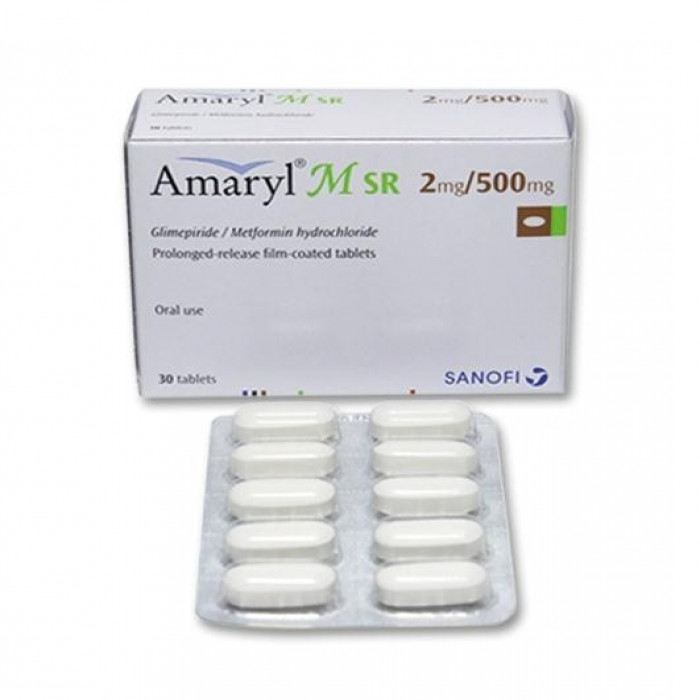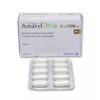Description:
Indications
This tablet is recommended for people with type 2 diabetes mellitus as a supplement to diet and exercise. –
- If metformin or glimepiride monotherapy fails to achieve sufficient glycemic control.
- Replacement of the glimepiride and metformin combination therapy.
Pharmacology
Sulfonylurea antidiabetic agent glimepiride may lower blood glucose concentration. Glimepiride’s primary mechanism of action appears to be dependent on enhancing the release of affront from active pancreatic beta cells. Glimepiride works in conjunction with glucose by increasing the beta cells’ susceptibility to a physiological glucose surge, resulting in affront emission. In addition, extrapancreatic effects like reduced basal hepatic glucose production increased sensitivity of the periphery to insult, and increased glucose uptake may also contribute to the movement of glimepiride. The hypoglycaemic effects of a single dose of glimepiride last for 24 hours in non-fasting diabetic patients.
The biguanide class of antihyperglycemic drug metformin hydrochloride is used to treat type 2 diabetes. Plasma glucose levels at rest and after meals are both decreased. It works in a different way from sulfonylureas and doesn’t result in hypoglycemia. Intestinal glucose absorption and hepatic glucose synthesis are both decreased by metformin hydrochloride.
Dosage
- The desired blood glucose level determines how much of this tablet to take.
- The smallest dose of this tablet required to achieve the desired metabolic control must be used.
- Regular blood and urine glucose tests must be performed while taking this tablet.
- Never increase the dose you take after making a mistake, like forgetting to take a dose.
- The amount of glimepiride needed may decrease over the course of treatment because better diabetes control is associated with higher insulin sensitivity.
- Therefore, it is important to think about timely dose reduction or stopping this tablet therapy in order to prevent hypoglycemia.
- The maximum dose that should be recommended each day is 8 mg of glimepiride and 2000 mg of metformin.
- The starting dose of this tablet should not be higher than the daily doses of glimepiride or metformin already being taken in order to prevent hypoglycemia.
- When switching from glimepiride and metformin are taken as separate tablets in combination therapy, the dosage currently being taken should be taken into consideration.
Administration
- The Amaryl tablet needs to be taken whole, without chewing, and with enough liquid (roughly a half glass).
- Take it right before or alongside your morning meal (usually breakfast). Don’t skip meals.
Interaction
For glimepiride:
Cytochrome P450 2C9 metabolizes the drug glimepiride (CYP2C9). When glimepiride is administered alongside CYP 2C9 inducers (like rifampicin) or inhibitors (like fluconazole), this should be taken into account.
When one of the following drugs is taken, for example, Hypoglycemia may occasionally occur due to a potentiation of the blood glucose-lowering effect. Pro inhibitors, anabolic steroids, male sex hormones, chloramphenicol, coumarin subordinates, cyclophosphamide, disopyramide, fenfluramine, fenyramidol, fibrates, fluoxetine, guanethidine, ifosfamide, MAO inhibitors, miconazole, fluconazole, para-aminosalicylic corrosive, pentoxifylline.
When one of the following medications is taken, for instance: acetazolamide; barbiturates; corticosteroids; diazoxide; diuretics; epinephrine (adrenaline) and other sympathomimetic agents; glucagon; laxatives (after prolonged use); nicotinic acid (in high doses); estrogens and progestogens; phenothiazines; phenytoin
Clonidine, beta-blockers, reserpine, and H2 receptor antagonists may either strengthen or weaken the blood glucose-lowering effect. The signs of adrenergic counter-regulation to hypoglycemia may be diminished or absent when sympatholytic medications like beta-blockers, clonidine, guanethidine, and reserpine are taken.
Alcohol consumption, whether acute or chronic, can alter the effectiveness of glimepiride in lowering blood sugar in unpredictable ways.
The impact of derivatives of coumarin can be strengthened or diminished.
Bile acid sequestrant: Colesevelam reduces the absorption of glimepiride from the gastrointestinal tract by binding to it. It is recommended to give glimepiride at least 4 hours before colesevelam.
Concomitant use is not advised with metformin:
Alcohol: Drinking too much alcohol increases the risk of developing lactic acidosis, especially when combined with fasting, malnutrition, or liver insufficiency. Avoid consuming alcohol and medications that contain alcohol.
Iodinated contrast agents: If the renal function has been reassessed and found to be stable, metformin must be stopped prior to, or at the time of, the imaging procedure and not resumed for at least 48 hours.
Combinations that should be used with caution include those where certain medications may negatively impact renal function and raise the risk of lactic acidosis. Close monitoring of renal function is required when starting or using such products in conjunction with metformin. Beta-2 agonists, diuretics, and glucocorticoids all have inherent hyperglycemic activity. Inform the patient and monitor blood sugar levels more frequently. ACE inhibitors might lower blood sugar levels. The anticoagulant effect of phenprocoumon may be lessened by metformin. It is therefore advised to closely monitor the INR. The hypoglycemic effect of metformin can be lessened by levothyroxine. When starting or stopping thyroid hormone therapy, it is advised to monitor blood glucose levels and, if necessary, adjust the metformin dosage.
Contraindications
For Glimepiride-
- In patients hypersensitive to glimepiride, metformin, other sulfonylureas, other sulfonamides, or any of the excipients of Amaryl M.
- In pregnant women.
- In breastfeeding women.
No experience has been gained concerning the use of glimepiride in patients with severe impairment of liver function and in dialysis patients. In patients with severe impairment of hepatic function, change-over to insulin is indicated, not least to achieve optimal metabolic control.
For Metformin-
- Hypersensitivity to metformin or any of the excipients.
- Any type of acute metabolic acidoses such as lactic acidosis Diabetic ketoacidosis, or diabetic pre-coma.
- Severe Renal failure or renal dysfunction (e.g., serum creatine levels >135 ?mol/L in males and >110 ?mol/L in females), GFR < 30 mL/min.
- Acute conditions with the potential to alter renal function such as Dehydration, severe infection, intravascular administration of iodinated contrast agents, etc.
- An acute or chronic disease which may cause tissue hypoxia such as cardiac or respiratory failure, recent myocardial infarction, shock
- Hepatic insufficiency.
- Acute alcohol intoxication, alcoholism.
- Lactation.
Side Effects
Hypoglycaemia, temporary visual impairment, nausea, vomiting, diarrhea, abdominal pain, urticaria & fall in blood pressure.
Pregnancy & Lactation
Glimepiride must not be taken during pregnancy; a changeover to Insulin is necessary. Patients planning a pregnancy must inform their physician, and should be shifted to Insulin. Lactation: Ingestion of Glimepiride with breast milk may harm the child. Therefore, Glimepiride must not be taken by lactating women. Either a changeover or a complete discontinuation of breastfeeding is necessary.
Precautions & Warnings
- The risk of hypoglycemia may be increased during the first few weeks of treatment, necessitating careful monitoring.
- The dosage of Glimepiride may need to be changed if this risk is present.
- Use in Special Populations Pediatric use: Safety and efficacy in pediatric patients have not been established. Hypoglycemia can almost always be quickly controlled by immediate intake of carbohydrates (glucose or sugar, for example, sugar-sweetened fruit juice or sugar-sweetened tea).
- Geriatric use: Overall, there were no differences in safety or effectiveness between elderly and adult subjects, but it is possible that some older people may be more sensitive. The risk of toxic reactions to this medication may be higher in patients with impaired renal function because the drug is known to be substantially excreted by the kidney. Renal function should be carefully considered when choosing a dose because elderly patients are more likely to have decreased renal function. It may also be helpful to monitor renal function.
- Use in renal insufficiency: Patients with NIDDM who have kidney disease may receive a starting dose of 1 mg of glimepiride, and the dose may be adjusted based on fasting blood glucose levels.
- Use in hepatic insufficiency: Hepatic insufficiency patients were not the subjects of any studies. Negative effects include hypoglycemia. Dizziness, asthenia, headache, and nausea are adverse events besides hypoglycemia.
- Effects of Overdose Overdosing, whether accidental or intentional, can result in severe, protracted hypoglycemia that can be fatal.
- Glimepiride overdose cases must be reported right away to a doctor. If a doctor has not already begun treatment, the patient must take sugar right away, preferably glucose, at the first sign of hypoglycemia.
Storage Conditions
Do not store at temperatures above 30?C. Keep out of the reach of youngsters and away from light.







Reviews
There are no reviews yet.